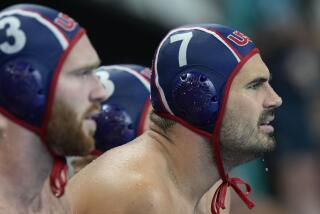Brought to Surface
- Share via
Adam Wright remembers the first time it happened to him.
He was about 18 years old and was playing in his first international tournament with the U.S. men’s water polo junior team.
“I was shocked,” he said. “I was just absolutely shocked.”
Welcome to the unseen world of water polo, where cheap shots aren’t considered cheap, but rather part of the game -- accepted and expected.
Water polo always has had the reputation of being a rough game, even above water. Referees are constantly blowing whistles to signal “ordinary” fouls. There is no limit to the number of these that can be called. When an ordinary foul is called, the team it was committed against gets three undefended seconds to put the ball in play.
Because the referees can’t see what goes on underwater, there obviously is no way to control it.
“Anything you can imagine goes on under there,” U.S. team member Dan Klatt said, “scratching, kicking, punching, pinching, knees to the groin, knees to the tailbone.”
Underwater cameras have allowed spectators to see just how violent the unseen part of the game can be, but Wright and Klatt said that the first time they were introduced to it they were surprised.
In the U.S., high school and college water polo coaches try to discourage the rough underwater play, Klatt said.
“The first time I got grabbed in an area I didn’t like ... I wanted to punch the guy,” Wright said, but eventually he got used to it.
“As you play more and more games and get more experience, it’s either let them do it to you, or protect yourself,” Wright said. “It’s not something you enjoy doing, but it’s something that you have to do.”
Eventually, Klatt said, the underwater struggle becomes almost inherent.
You don’t even think about it, he said, because if you do, your game will suffer.
“Usually you are just swimming along, and you get hit. You go, ‘ouch,’ and just move on,” he said. “Things you never thought you would do when you were 14 years old, you do now.”
Klatt is a two-meter defenseman, an inside position that traditionally takes the most abuse. He said teams are always trying to get an “exclusion” foul called against the other team.
Exclusion fouls are more serious than ordinary fouls and result in a player being forced to leave the game for 20 seconds, leaving one team in a power play-type situation.
Anything a player does to achieve that goal, Klatt said, is acceptable.
“Some players are more dirty than others,” he said, “and I don’t like people who do it for no reason, but if somebody’s doing it to make sure [the opponent] can’t score or to protect himself, it’s OK.”
Although it’s part of the game, Klatt said that doesn’t mean it’s part of the strategy. Coaches don’t instruct players to do it, and players don’t talk about the fact that it has to be done. The goal, Klatt said, is to win the game -- not hurt your opponent.
Despite the honest intentions, injuries are the consequence. It’s rare, though, for a player to be so hurt that he is forced to leave the game. Of the six or seven nose breaks Klatt has suffered -- or at least noticed -- he only left the pool until the bleeding stopped.
“To be honest, it doesn’t even bleed that much anymore,” he said, adding that even when his ribs were broken and dislocated, he didn’t leave the water.
“You finish a lot of games with a fat lip or a cut, some scrape marks on your face, and there are a lot of claw marks on guys’ backs,” he said.
But all that isn’t what bothers him. It’s the knee to the groin that he dreads the most.
“That’s the worst part,” he said. “You’re just kind of floating there. In any other sport you can just drop to the ground on your knees in pain or agony. In ours, you have to somehow get to the side of the pool.”
More to Read
Go beyond the scoreboard
Get the latest on L.A.'s teams in the daily Sports Report newsletter.
You may occasionally receive promotional content from the Los Angeles Times.






